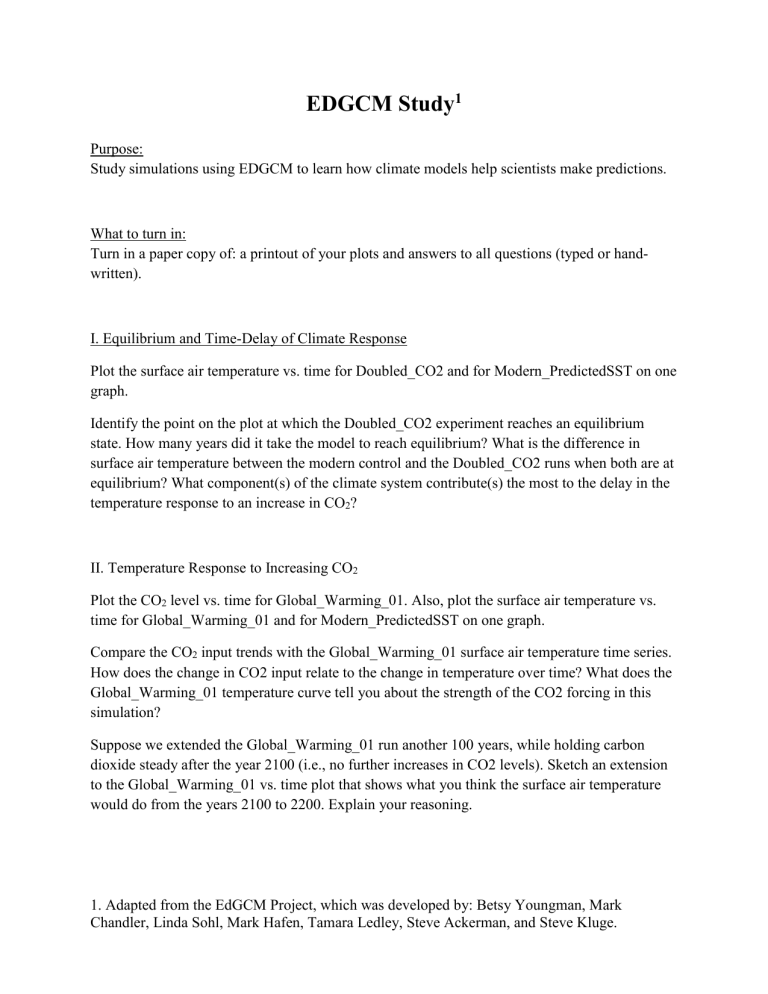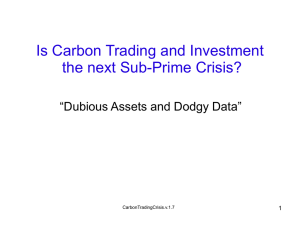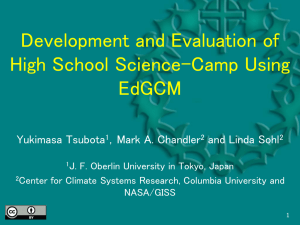Due Friday - EDGCM Study

EDGCM Study
1
Purpose:
Study simulations using EDGCM to learn how climate models help scientists make predictions.
What to turn in:
Turn in a paper copy of: a printout of your plots and answers to all questions (typed or handwritten).
I. Equilibrium and Time-Delay of Climate Response
Plot the surface air temperature vs. time for Doubled_CO2 and for Modern_PredictedSST on one graph.
Identify the point on the plot at which the Doubled_CO2 experiment reaches an equilibrium state. How many years did it take the model to reach equilibrium? What is the difference in surface air temperature between the modern control and the Doubled_CO2 runs when both are at equilibrium? What component(s) of the climate system contribute(s) the most to the delay in the temperature response to an increase in CO
2
?
II. Temperature Response to Increasing CO
2
Plot the CO
2
level vs. time for Global_Warming_01. Also, plot the surface air temperature vs. time for Global_Warming_01 and for Modern_PredictedSST on one graph.
Compare the CO
2
input trends with the Global_Warming_01 surface air temperature time series.
How does the change in CO2 input relate to the change in temperature over time? What does the
Global_Warming_01 temperature curve tell you about the strength of the CO2 forcing in this simulation?
Suppose we extended the Global_Warming_01 run another 100 years, while holding carbon dioxide steady after the year 2100 (i.e., no further increases in CO2 levels). Sketch an extension to the Global_Warming_01 vs. time plot that shows what you think the surface air temperature would do from the years 2100 to 2200. Explain your reasoning.
1. Adapted from the EdGCM Project, which was developed by: Betsy Youngman, Mark
Chandler, Linda Sohl, Mark Hafen, Tamara Ledley, Steve Ackerman, and Steve Kluge.
III. Spatial Distribution of Anomalies
In the “Maps” tab of the “Analyze” window, average the last 5 years of Global_Warming_01 and
Modern_PredictedSST. Print an annual global map of the difference in surface air temperature between the global warming run and the control run. Check the “interpolate” option on the map to smooth the map. Also, center the color scale so that it is symmetric around a difference of zero degrees.
What does the surface air temperature anomaly shown in your map tell you about the
Global_Warming_01 run in general compared to the modern control run? Why do you think the temperature change is greater at high latitudes? What other geographic patterns do you notice in the temperature anomalies?
Since the carbon dioxide increase was uniform (CO
2 is a well-mixed gas in the atmosphere), we must examine other climate variables to explore why the temperature change is not also the same everywhere.
Print global maps of the difference in snow/ice cover and the difference in ice cover between the global warming run and the control run. Center the color scales so that they are symmetric around a difference of zero degrees.
Describe the geographic relationship between decreased snow/ice cover and temperature increase. How do you account for those areas that show little or no change in snow cover?
IV. Using IPCC CO
2
Level Predictions in the Model
Plot the CO
2
level vs. time for IPCC_A1FI_CO2. Also, plot the surface air temperature vs. time for IPCC_A1FI_CO2 and for Modern_PredictedSST on one graph.
Predict where the IPCC graph will be in 50 more years - explain your prediction.
Plot the surface air temperature difference between IPCC_A1FI_CO2 and
Modern_PredictedSST vs. time. Compare your plot to the NASA plot of observed temperatures shown below. How to the plots compare in the time region that they overlap? Does this say anything about the accuracy of your model?
1. Adapted from the EdGCM Project, which was developed by: Betsy Youngman, Mark
Chandler, Linda Sohl, Mark Hafen, Tamara Ledley, Steve Ackerman, and Steve Kluge.
In the “Maps” tab of the “Analyze” window, average the last 5 years of IPCC_A1FI_CO2. Print annual global maps of the difference between this run and the control run for the following parameters: snow and ice coverage (you might choose Dec, Jan, and Feb instead of annual for this) precipitation evaporation low level cloud coverage surface air temperature max surface air temperature
Check the “interpolate” option on the map to smooth the map. Also, center the color scales so that they are symmetric around a difference of zero.
For each map, discuss how different parts of the globe change. Specifically, relate latitude variations and land vs. ocean.
All the different climate variables are related to each other. Discuss the relationship between the maps you made. According to the maps, how do the different variables affect each other?
1. Adapted from the EdGCM Project, which was developed by: Betsy Youngman, Mark
Chandler, Linda Sohl, Mark Hafen, Tamara Ledley, Steve Ackerman, and Steve Kluge.
V. A Second Opinion
Find predictions on the internet about levels of a few of the variables that EdGCM can include trends for. Generate another run that goes from 1958 to 2100 and repeat part IV. Compare your new results to those of part IV.
VI. Conclusions
Discuss the strengths and weaknesses that you see (or have questions about) in this climate model. How well do you trust its ability to make predictions? Give specific reasons for your position. If you were a member of congress, what questions would scientists have to answer before you would be willing to make laws governing emissions?
1. Adapted from the EdGCM Project, which was developed by: Betsy Youngman, Mark
Chandler, Linda Sohl, Mark Hafen, Tamara Ledley, Steve Ackerman, and Steve Kluge.









